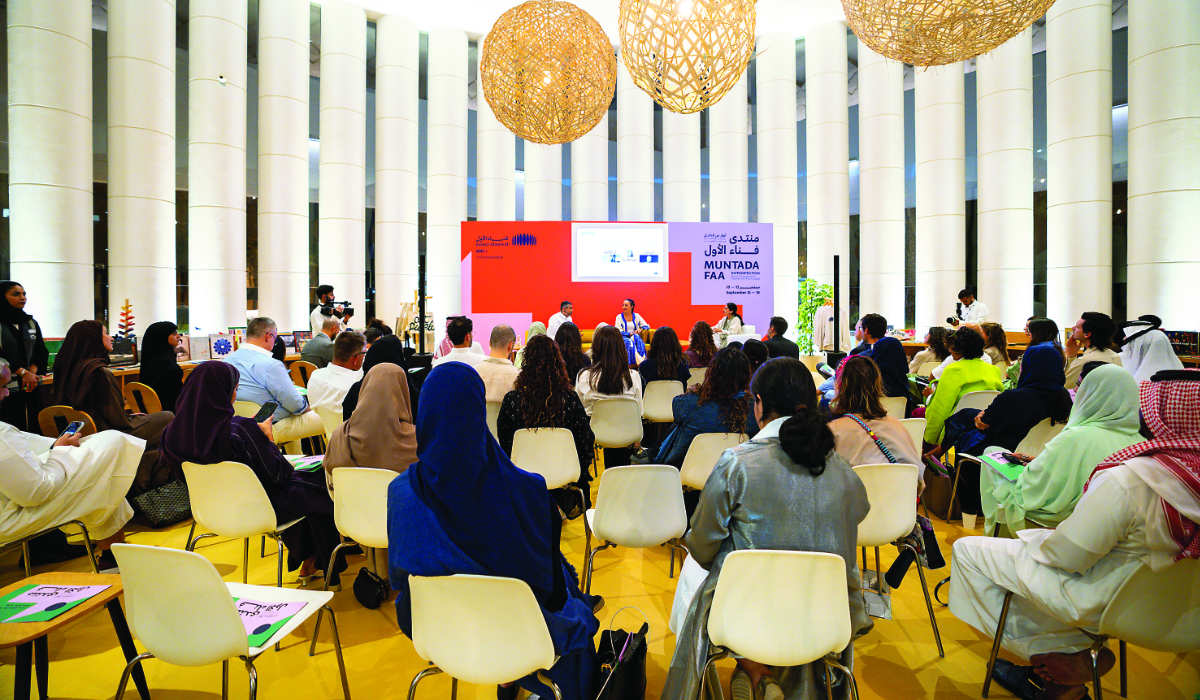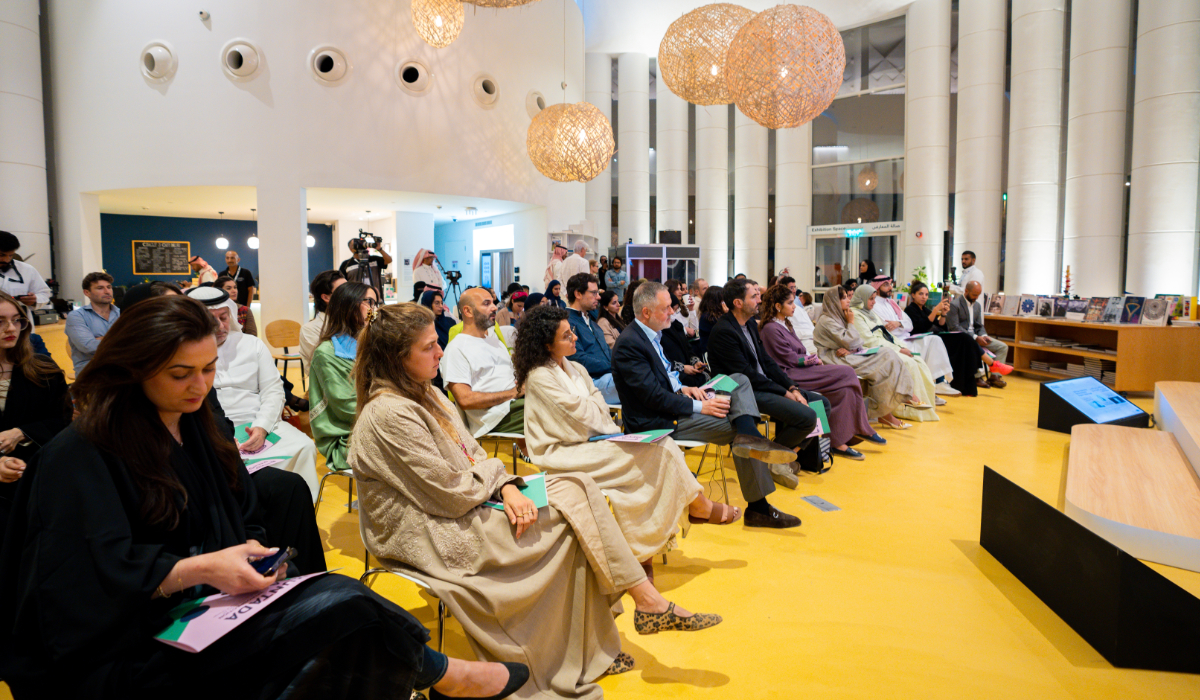A Palestinian astronaut plants the national flag on the moon and then floats away into space. These sequences, based on iconic images from the US moon landing and Stanley Kubrick’s ‘2001: A Space Odyssey’, are at once startling and moving because they express both profound hope and sadness. The images, from the short film, ‘A Space Exodus’, are the work of the Palestinian artist, Larissa Sansour, whose name made headlines last year when the high end clothing company, Lacoste, forced the withdrawal of her shortlisted photography artwork from a competition being held at the Elysee Museum in Lausanne, Switzerland. Her work was apparently considered ‘too pro-Palestinian’. In response to the censorship, the museum broke off relations with Lacoste, the corporate sponsor, and canceled the competition that carried a first prize of £21,000. The story of the censorship made headlines across the world, and Sansour and her Danish husband found themselves at the center of a media storm, which proved both uplifting and exhausting.
The censored work, Nation Estate, which has since been developed into a futuristic short film, places the Palestinian people in a skyscraper, supported by the international community, with each floor representing a city — Jerusalem, Bethlehem, Ramallah. The citizens in this luxury development can move about freely, via elevators, (no checkpoints), but it is a sterile environment affording ‘freedom’ within the confines of an artificial construct. The skyscraper has views over the Dome of the Rock of Jerusalem — so the inhabitants overlook the real Jerusalem forcing them to face a painful reality of exclusion and separation.
Speaking from her London apartment, Sansour said she and her husband are taking a much needed rest after completing the film version of Nation Estate, which took nine months of intense work. Ironically, Sansour had wanted to win the Lacoste Nation Estate photography prize because she needed funding to make the film. In the event, the publicity that ensued from the ban raised her profile, and she was able to pour the resulting profits from sales of her work into financing the high end production film made in Copenhagen.
Sansour was born in Bethlehem; her parents met in Moscow where her Palestinian father was studying mathematics. Her mother is Russian and worked in radio in Moscow. Upon returning to Palestine, her father was invited by the Vatican to found Bethlehem University. The family home, recalled, Sansour, was like an unofficial embassy, full of leading thinkers and political discussion. As a child she drew instinctively and her father encouraged her precocious talent by finding her art classes to attend.
She remembers her childhood as ‘sunny’ but punctured by disturbing moments. “When I was seven I remember Israeli soldiers pointing their guns at me when I was walking out of school. It was frightening. I think what it does psychologically, and you can’t shake that off, is that you feel that not all humans are equal. As a kid that sends a very strong message — ‘You’re Palestinian so you will be treated like dirt. It becomes cemented — this dehumanization — from a very early age.”
As a Christian she recalled that religious divisions were not notable during her childhood, but that a different atmosphere prevails today. “I do feel that a tension is building up between religions but I think Palestinians are still united against the occupation. But what’s starting to happen is that religion has got conflated with fighting for justice. I think that happens when you’ve reached the end of your tether; where you are trying to make sense of things, and sticking to a belief is what makes people feel stronger in that fight. It really happened once the Intifada started because I don’t remember it being like this,” she said.
When she was 15, her family life with parents, brother and sister, was harshly disrupted with the onset of the First Intifida, a Palestinian uprising against the Israeli occupation of the Palestinian Territories which lasted from December 1987 to 1993. Her parents, in their efforts to protect her, sent her to boarding school in England, where she studied for her ‘O’ and ‘A’ levels. Her memories of this time, she said, are full of gloomy grey skies and a feeling of alienation. Those years sowed the seeds of an aversion to London which she has only recently overcome. She now loves the international buzz of the city with its vibrant cultural scene.
After returning to Palestine for High School, she then set off for the United States, studying art first in Baltimore and subsequently in New York, where she completed her Masters.
She continued her Fine Art studies in Copenhagen, Denmark, where she met her husband, a writer, who works with her on the film scripts. The couple, who moved to London three years ago, have a five month old daughter, whose joyful arrival has meant a shift in priorities.
Talking to Sansour you get a sense of a calm intelligence and a keen awareness of her Palestinian identity which shapes her art.
Her film ‘A Space Exodus’, is currently showing at the Edge of Arabia ‘Come Together’ Exhibition in the heart of London’s East End. Artists from across the Middle East are showing contemporary work using a wide range of mediums expressing powerful, fresh ideas. At the press preview some of the artists spoke about their work. For Saudi Arabian street artist, Abdullah Mohammed Alshehri, who comes from Riyadh, this is his first visit to London. He explained that his stencil image of the Saudi Olympic runner, Sarah Attar, had been seen by the Edge of Arabia director Stephen Stapleton, who subsequently invited him to participate in the exhibition.
Alshehri’s image of Attar running is an expression of his admiration for her brave efforts in the London Olympics, where she received warm applause at the end of the 800 meters track race. She came in last, but her participation was a first for Saudi Arabian women in athletics, and lights the way for others to follow.
Alshehri said, “I support her — I made this image in the street of her running. Some people liked it — some not. People are not so familiar with street art — it’s something new.” Alshehri said of London: “It’s very beautiful — so international — I’ve met a lot of other artists. This experience can give you inspiration and information you didn’t have before.”
Edge of Arabia co-founder and director, Stephen Stapleton said, “Saudi Arabia has an exciting arts scene and it’s very authentic. It’s a lot of really great local people taking initiative — artists, people setting up a gallery, or young Abdullah taking his art to the street.”
He added: “Art boils down to you or me being creative. It’s about people with passion and imagination. If you can encourage that, the rest will take care of itself. It takes hundreds of years to develop it. That’s OK, we don’t need to rush.”
He noted the initiatives among local artists in Qatar led by people such as Tariq al Jaidah, founder of the Waqif Art Center, and the new Qatar Arts Center.
The founding partner and sponsor for Edge of Arabia is Abdul Latiff Jameel Community Initiatives.
The exhibition features a striking artwork called ‘The Capitol Dome’ by Saudi artist and Edge of Arabia co-founder, Abdulnasser Gharem. It is a replica of the Capitol Dome in Washington; when you peer into the Dome you see that the interior resembles a mosque. This triggers questions about western based democratic systems being fused with Arab cultures.
Edge of Arabia is unique in engaging directly through educational programs with the local East End community where the exhibition is staged. This approach is appreciated in an area of London where after years of social deprivation a burgeoning arts scene has given a new lease of life to the once run down streets, but left many residents feeling excluded. “We’re proud to be the education partner with Edge of Arabia,” said Narull Islam, co-founder of the Mile End Community Project.
“This is probably the first exhibition that has really engaged with the local community. They have got the young people involved; that’s really refreshing. It gives our young people confidence to meet renowned artists.”
This view was echoed by local tribal artist and sculptor, Muhsin Ahmed, and graphic designer and licensed graffiti artist, Mohammed Sadek. They were delighted to meet Riyadh artist Alshehri.
“This exhibition inspires me because of the way people from the Middle East are coming here and bonding with each other’s communities through their art work,” said Mohammed Sadek. “They see our art work on the streets and we see their work in galleries, and it is really inspiring to see the two coming together.”
French-Algerian post-conceptual artist, Faycal Baghriche, talked about his exhibit, ‘Blue Globe.’ “It is a globe spinning so fast that you can see no continents, countries or borderlines. This is how I see the world today — moving very fast — with such intense circulation of people through immigration that we don’t recognize who is coming from where,” he explained.
Iraq born multi-media artist, Sama Alshaibi, whose family fled Iraq during the Iran-Iraq war, spoke about her work, ‘Vs. The Brother’. This video depicts on a split screen the images of a female aerial artist spiraling around on a cocoon of silk rope which gradually envelops her, and a young man spinning in frenzied circles, or donuts, in his sports car. At first sight, the young man seems freer than the woman — but on reflection both are trapped and circumscribed in their actions. “When you look at them you realize they are both trapped in a cycle of expectation — the man to prove his masculinity through aggressive behavior, and the woman gradually to withdraw into domestication and become removed from the public sphere. There is an equilibrium of grievances there and boundaries for both,” explained Alshaibi. Now based in the US, she has lived in Saudi Arabia, the UAE and Jordan and her work continues to take her across the Middle East and North Africa.
— Edge of Arabia ‘Come Together’ Exhibition is showing daily at the Truman art space, 81 Brick Lane, London E1 6QL, from Oct. 7 – 28.
E-mail: [email protected]
































